
New Items - Photos, page 2
W.P. Snyder Jr. and other Towboats
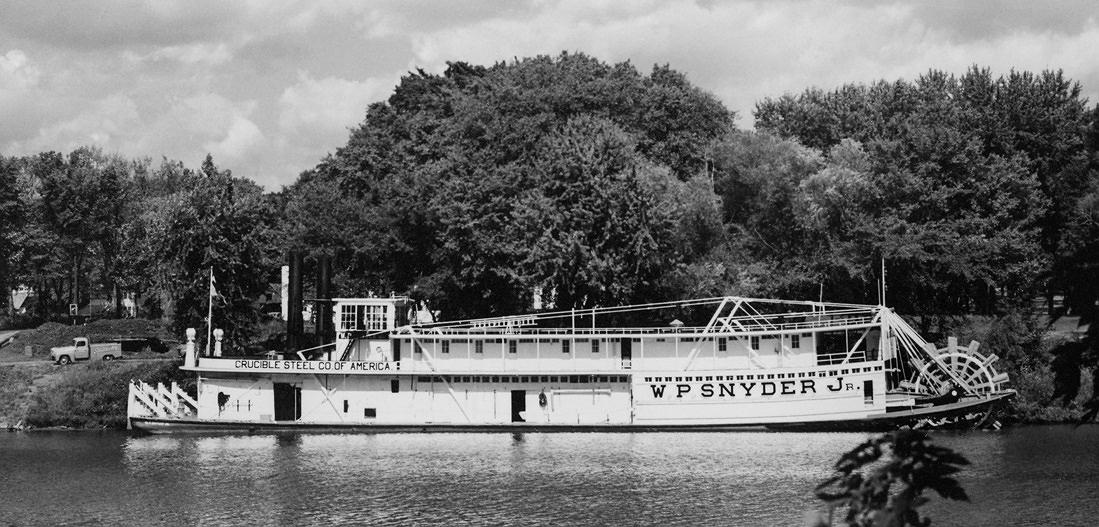
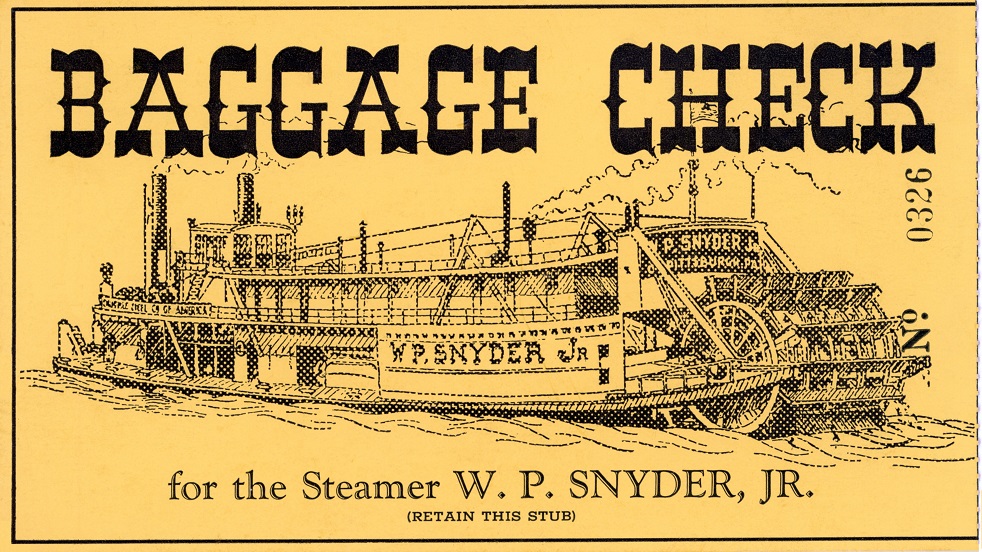
Souvenirs of the W.P. SNYDER JR,'s last cruise!
Recent discoveries for the SNYDER page: A pair of unusual collectibles from the W.P. SNYDER JR.'s "last cruise" in 1955.
Souvenir Baggage check stub 3.75 x 6.50 inches for a bunk in one of the limited number of staterooms for a officers (such as Fred Way who was Captain of the SNYDER on this trip), crew members and invited guest passengers.
The text below by Durward Hoag was printed on the back of the photo taken at Marietta, Ohio—of the W. P. SNYDER JR., while she was moored in the Muskingum River at the foot of Sacra Via on Sept 28, 1955 ~ File No. 55 - 1351 © 1955 BY S. DURWARD HOAG, MARIETTA, OHIO
HISTORIC LAST CRUISE OF THE W.P. SNYDER JR.
From Brownsville, Pennsylvania on the Monongahela River down to Pittsburgh, Pennsylvania, then down the Ohio River with stops at Rochester, Pennsylvania, East Liverpool, Ohio, Wheeling, West Virginia, then arriving at her final destination - Marietta, Ohio.
The voyage began on Monday Sept. 12th, 1955 and concluded on Friday Sept 16th, 1955. These photos were taken on Tuesday. Sept. 13th. Upon departure from Pittsburgh and on Friday. Sept. 16th., 1955 upon arrival at Marietta, Ohio
When the sternwheeler W. P. SNYDER JR., arrived on the Muskingum River in September 1955, she resigned her position as workhorse of the river system to become a public museum, honoring the once proud fleet of steamboats which brought prosperity and a rich tradition to the American heartland.
The W. P. SNYDER JR., was given to the Ohio Historical Society by the Crucible Steel Company of America. It is administered as a section of the River Museum of the Campus Martius State Memorial, Marietta. The River Museum, which displays thirty scale models, oil paintings and photographs, and whistles and other mementoes of river boats of the past and present, was developed in the Campus Martius Museum by the Sons and Daughters of Pioneer Rivermen, formed in 1939. This organization of 550 active members together with citizens of Marietta assisted in acquiring the W. P. SNYDER JR., and transferring her to her present location.
The W. P. SNYDER JR., was born the W.H. CLINGERMAN in 1918. Ruilt by the firm of James Rees & Sons Company Pittsburgh, for the Carnegie Steel Company, she was used primarily to bring coal from the mines along the upper Monongahela River to the Carnegie works down river at Clairton, though she also pushed steel tows and once made a trip at least as far as Memphis. Her first pilot was Capt. A. 0. Ackard a notable river man, later the master of river transportation for Carnegie Steel. Capt. Calvin Rlazier, who wore his white hair Ruffalo-Rill-style, also guided her And there were other well- known pilots.
In 1938 Carnegie renamed the boat the J. L. PERRY, the name she retained until the spring of 1945, when for a short period she carried the name A-l In the fall of 1945 the Crucible Steel Company of America bought her and gave her her present name. As the W.P. SNYDER JR.,, she continued to tow coal for seven or eight years, serving the Crucible plant at Midland, Pennsylvania. She was finally retired, still m good condition, to be replaced by a diesel towboat.
Mounted on a steel hull, the W. P. SNYDER JR.,is 175 feet long and 32.3 feet wide and has a paddlewheel 21 feet in diameter on the stern. On the river she is known as a "poolboat," since her pilothouse is set forward on the second deck, rather than on the roof. This was done to enable her to operate under the low bridges on the Monongahela. The boat is equipped with two sets of compound engines which generate 750 horsepower Each engine has a high pressure cylinder fourteen inches in diameter, a low pressure cylinder twenty-eight inches in diameter, and a common piston stroke of seven feet. The exhausted steam from the low pressure cylinders is carried into a surface condenser and pumped from there into the boilers. The boiler plant consists of four "western river boilers," each twenty-eight feet long and forty inches in diameter In each boiler are two fifteen-inch flues through which the flame, having passed under the boilers from the flame bed, returns forward and is piped into the smokestacks. The boiler fhel is bituminous coal, fed to the fireboxes by automatic stokers.
Although the W.P.SNYDER JR., incorporated the improvements of its day, many of the characteristics of her nineteenth century predecessors were retained. There is the elaborate "hog chain" support, a system of steel cables, mounted on posts, stretching along the sides of the boat to keep it from "hogging," or buckling in the center, and to help carry the weight of the paddlewheel; there is the orthodox pilotwheel, now only for emergency use. In case the automatic steering apparatus fails, there is the bell signal system from the pilothouse to the engine room, identical to that of Mark Twain's day; and there is the stateroom and cabin construction just as it was on riverboats a century ago.
The photograph was part of a collection taken by S. Durward Hoag, Marietta. Ohio for the purpose of recording for posterity this dramatic and epic event'
Copyrighted 1955. If used for any publication, due credit must be given. Complete sets of these photographs have been presented to The Marietta College Library, Campus Martius Museum and the River Museum, The Crucible Steel Company of America, Pittsburgh, Pa., and Captain Frederwick Way, Jr. of Sewickley, Pennsylvania noted and famous Ohio River historian, author, pilot and captain and who was the skipper of the W. P. SNYDER, JR., on her historic last cruise.
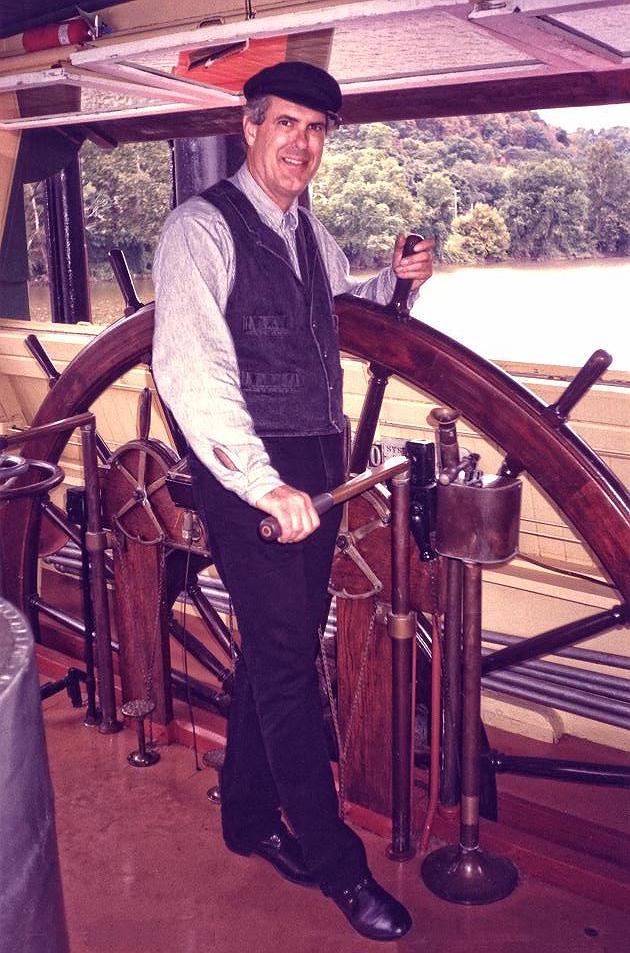
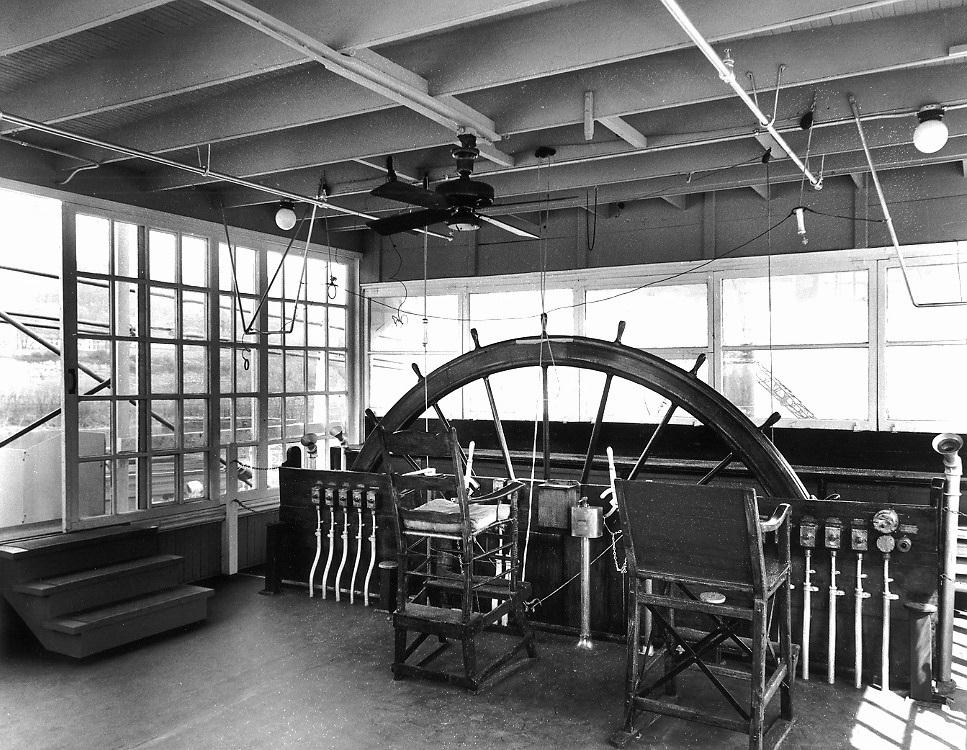
Best photo of the interior of the SPRAGUE's pilot house. She had the biggest pilot wheel of them all (13 1/2 feet). Wish I could have visited the boat before she was lost to fire in '74.
Photo Courtesy of Murphy Library at the University of Wisconsin - La Crosse Steamboat Collection Photographs
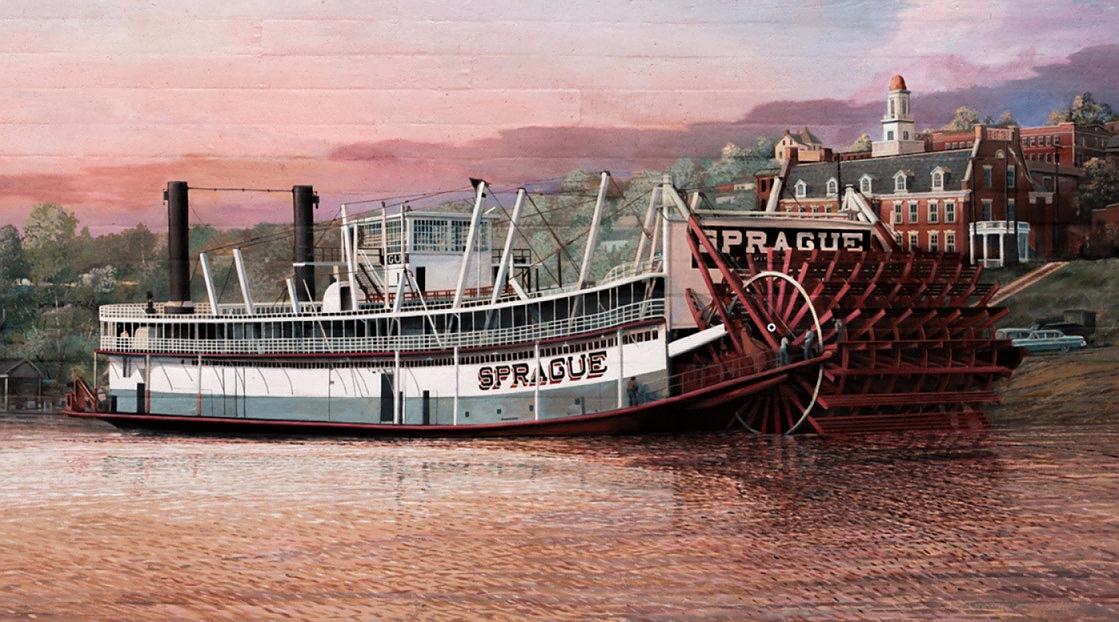
SPRAGUE mural on Vicksburg, Mississippi flood wall
This $16,500 mural of the SPRAGUE, painted by Robert Dafford Murals and completed in March of 2007, was purchased with a combination of funds remaining from Vicksburg's SAVE OUR SPRAGUE committee and donations from Dr. Walter Johnston Jr., Steve Golding and Vicksburg Factory Outlets.
(Excerpted from an article in the Vicksburg Post published on the 3rd of March, 2007).
vicksburgpost.com
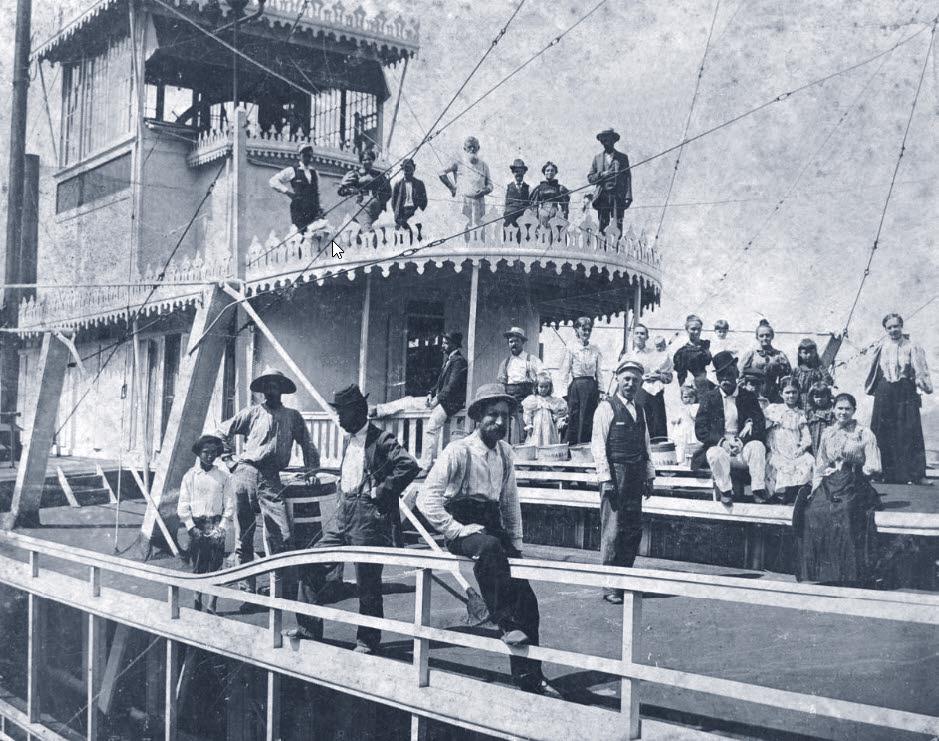
Oakland (Towboat, 1872-1914)
Sternwheel Towboat
Way's Steam Towboat Number T1945
Built at Pittsburgh, Pennsylvania, 1872 in grand packet-style with gingerbread roof trim on the pilot house & texas, she also had fancy-topped stacks (which can't be seen in the above photo).
Built by Captain Tom Fawcett and Captain Billy Smith for towing coal from Pittsburgh to New Orleans.
A fast boat when traveling light, she ran Cairo to Portland, Kentucky, 400 miles with several stops, in 31 hours.
She went from Salt River to Louisville, 20 miles with one stop, in less than two hours.
She took some record grain tows south when working for St. Louis and Mississippi Valley Transportation.
She towed the showboat NEW SENSATION during the Spring of 1880.
After towing coal for the People's Coal Company, she was acquired by the Combine, who operated her until 1913 and then rebuilt and renamed her F. M. WALLACE in 1914.
Her roof bell had been presented to Captain Billy Smith by A. Fulton and Son, Pittsburgh, and later was on the CRUCIBLE which was under the command of Captain Billy's grandson, Captain Wallace A. Smith.
Owners:
Captain Tom Fawcett and Captain William "McKeesport Billy" Smith (1872)
St. Louis & Mississippi Valley Transportation Company (1880-September 1901)
People's Coal Company, Pittsburgh (September 1901-1907)
Monongahela River Consolidated Coal and Coke Company, a.k.a the Combine 1907-1913.
Officers & Crew:
Gus Seifert and Billy Smith (1877)
Captain John W. Pierce (circa 1880-1901)
George Clark (master, spring 1880)
Captain Cal Blazier and Captain Billy Stout (circa 1901-1907)
Captain George R. Bower (chief engineer, 1907-1911)
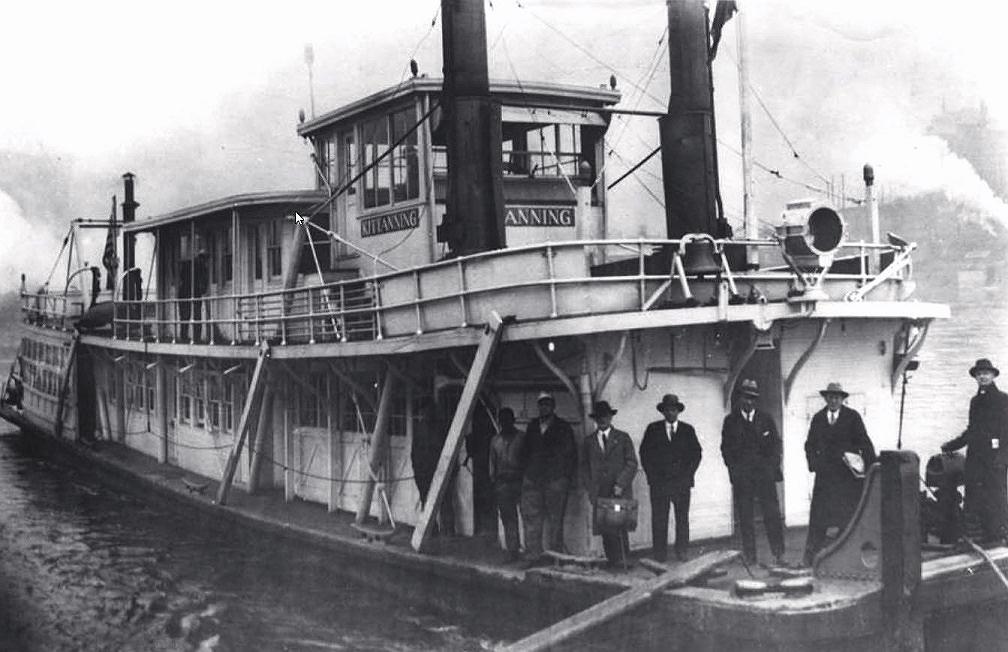
Towboat Kittanning 31st March 1928
Kittanning 1921-1930
Oil City PA, March 31, 1928.
First steamboat to Oil City since 1897.
George A. Zerr, river editor Pittsburgh "Post Gazette" with briefcase.
Public Library of Cincinnati and Hamilton County.
Genealogy & Local History Department
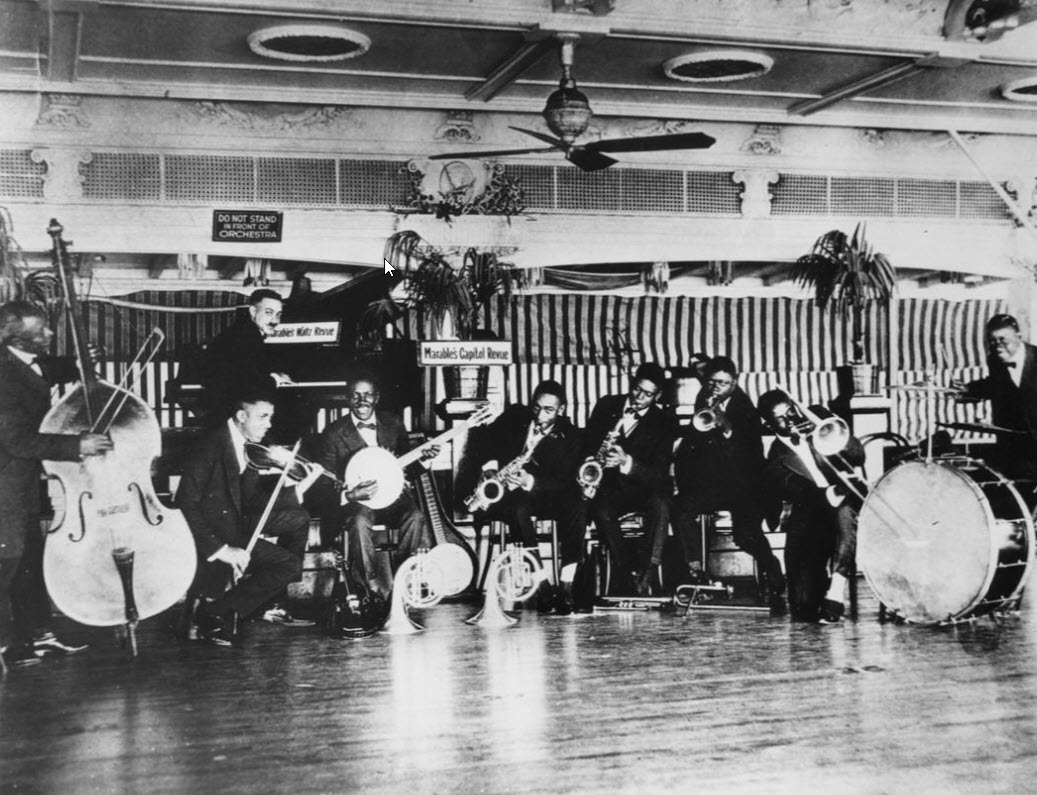
Jazz band on the CAPITOL : Fate Marable's Capitol Revue Band, 1919
Fate Marable's Capitol Revue Band, 1919.
Photo taken onboard the steamboat Capitol, 1919.
Musicians Left to right:
Henry (Hy) Kimball, bass
Boyd Atkins, violin
Fate Marable, piano (and leader)
John St. Cyr, banjo
David Jones, sax
Norman Mason, sax
Louis Armstrong, cornet
James Brecheur, trombone
Baby Dodds, drums
Photo credit: Duncan P. Schiedt collection.
Cincinnati Public Library Digital Collection
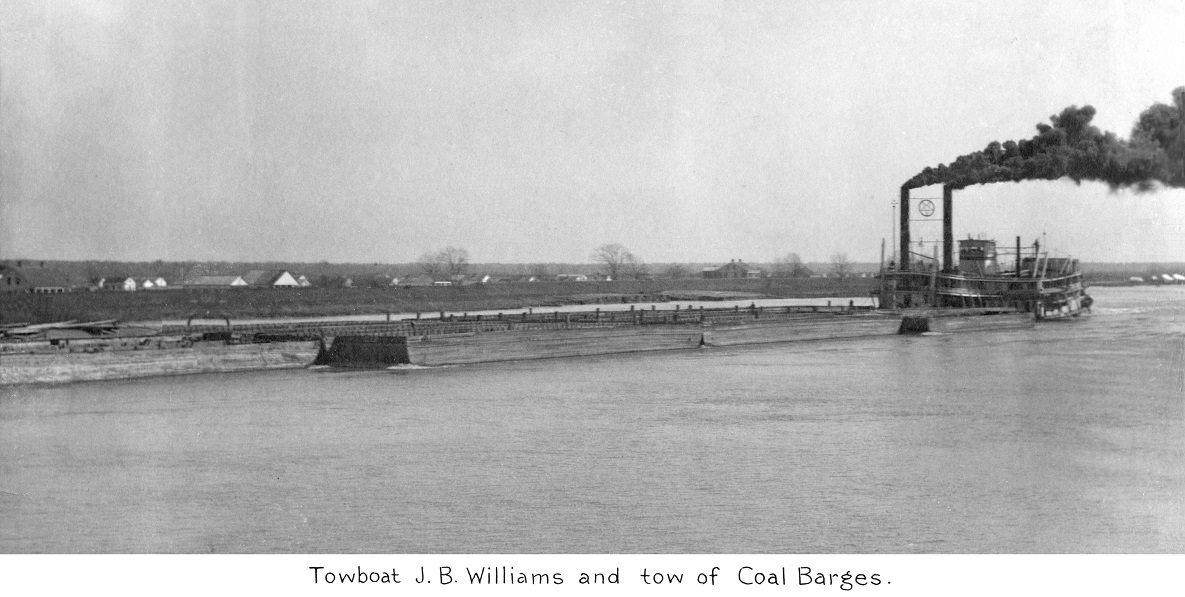
Towboat Joseph B. Williams & Coal Barges
Large photo from and an unknown album of the Towboat JOSEPH B. WILLIAMS & Coal Barges circa 1898
JOSEPH B. WILLIAMS (1876-1914)
Sternwheel Towboat
Way's Steam Towboat Directory Number T1452
Hull was built in 1876 at Freedom, Pennsylvania then completed at Pittsburgh
Owned by: Grand Lake Coal Company
I.D. Risher and Company
C. Jutte and Company Combine
Operated on the Ohio and Mississippi rivers
Came out with a jet condenser system which was unique in her day. Was in the coal-towing business. On her first trip south she was towing only a fuel flat and attempted to break the speed record downstream between Cincinnati and Louisville; she did not succeed.
In the spring of 1877, she was stranded on Island 63 after breaking her shaft and going aground. Her hull was badly warped but was temporarily "fixed" so as to allow her to return to Pittsburgh for repairs.
She cost in excess of $100,000 when new; when sold at a U.S. Marshal sale to C. Jutte, she sold for only $21,000.
She handled her largest coal tow between Cairo and New Orleans while she was owned by C. Jutte. On March 28, 1898, she hooked into 52 coal boats, four barges and four flats with a total of 1,453,000 bushels of coal. The length of this tow was 886 feet and it was 322 feet wide.
This whole fleet was only together for 429 miles of the entire distance of the trip between Louisville and New Orleans.
Other large loads handled by the Joseph B. Williams were 32 loads containing 600,000 bushels of coal (a world record at that time) taken to New Orleans in the 1880s and in 1897, a load consisting of 37 coal boats, eight barges, one coal flat and two cask boats which she took south from Louisville.
Another time Captain Dan Varble took her over the Louisville falls with 27 coal boats, one barge and one box boat, assisted by the Wash Gray, the Transit and the Fulton. She went down through the Indiana Chute which was 360 feet wide at the time.
Along with her successes, she also had a few losses: she seems to have lost an entire tow early in her career at Island 63; in January 1900 she lost 17 coal boats out of 39 at Point Pleasant, Missouri while en route to New Orleans; she hit the bank at Carrolton, Kentucky and lost seven coal boats and had lost four others near Sewickley, Pennsylvania in December 1901; she lost 23 coal boats out of a tow of 31 plus 10 model barges below Natchez in March 1903; in February 1909 she lost 26 loads plus one model barge at Glasscock below Natchez--damage estimated at $83,000.
She sank below Golconda, Illinois in August 1905 at Sisters Island and ripped a 40-foot hole in her hull; she was taken to Paducah for repairs. In early 1882 she towed the showboat NEW SENSATION to Louisville.
She was the largest and most powerful towboat on the Ohio and Mississippi rivers
Burned at Cairo, Illinois on October 14, 1914 and then sank
Officers & Crew:
Ben Cox (pilot, 1877); John Onion (pilot, 1877); Levi Shook (chief engineer); Henry Staley (chief engineer, 1882); Herbert M. Underwood (engineer, 1898); Ellis Underwood (engineer, 1898); Thomas W. Martin (engineer); Captain John "Jack" Williams (master, 1880); Captain Tom Patterson (pilot); Captain Isaac B. Williams (master); Captain James G. Beazell (master, 1898); George W. Clark (pilot, 1897-98); Lute N. Moar (pilot, 1898); Henry Lindenburn (striker pilot, 1898); James Underwood (engineer, 1898); John W. Shook (mate, 1898); Ash Barnhart (steward, 1898); Sharp Packer (pilot, 1897); J. P. Smith (steersman, 1897); Charles R. Nadal (steersman, 1897); James Morrison (carpenter); Pat Welsh (2nd mate); Captain S. R. Dawson (pilot, 1897) and Mr. Ecker (pilot, 1897).
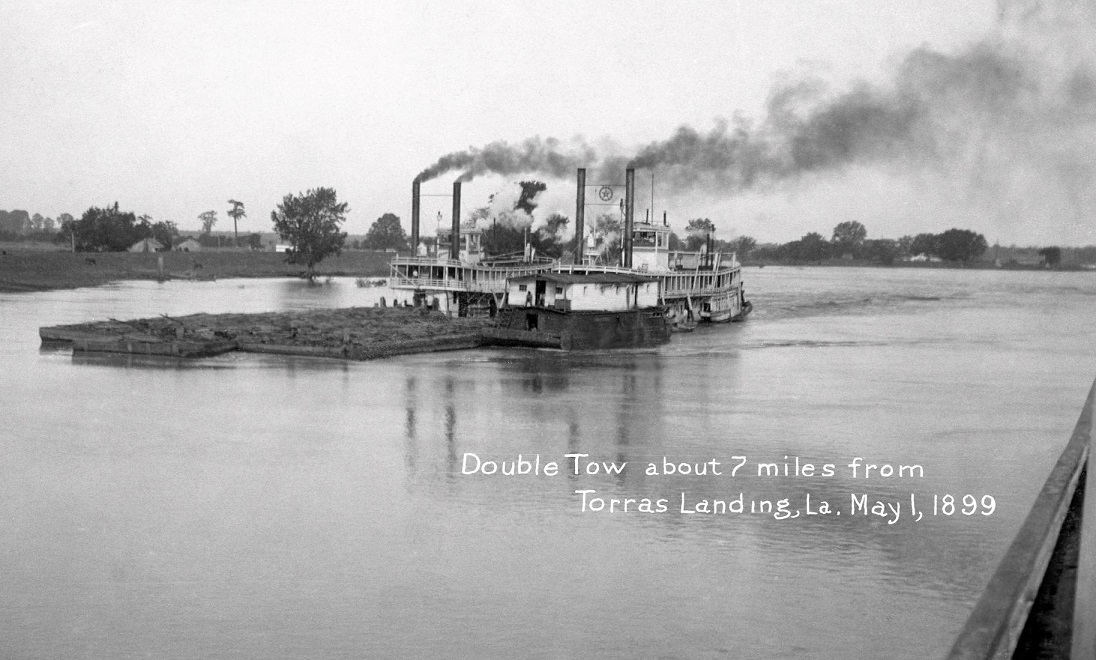
"Double Tow" about 7 miles from Torras Landing, Louisiana photographed on 1st May, 1899
Detail of photograph taken on 1st May, 1899 of a two unidentified towboats lashed together into a " Double Tow" about 7 miles from Torras Landing, Louisiana which is on the west side of the Mississippi River north of Red River Landing; south of Monkey Island and north of Angola Landing which is on opposite shore (on the east side of the river).
In addition to the barges the 2 towboats that were pushing at least 3 barges loaded with unidentifiable cargo, there is also a "Quarter boat" (a bunk house for hired hands who were kept busy building or maintaining levees among other diverse projects).
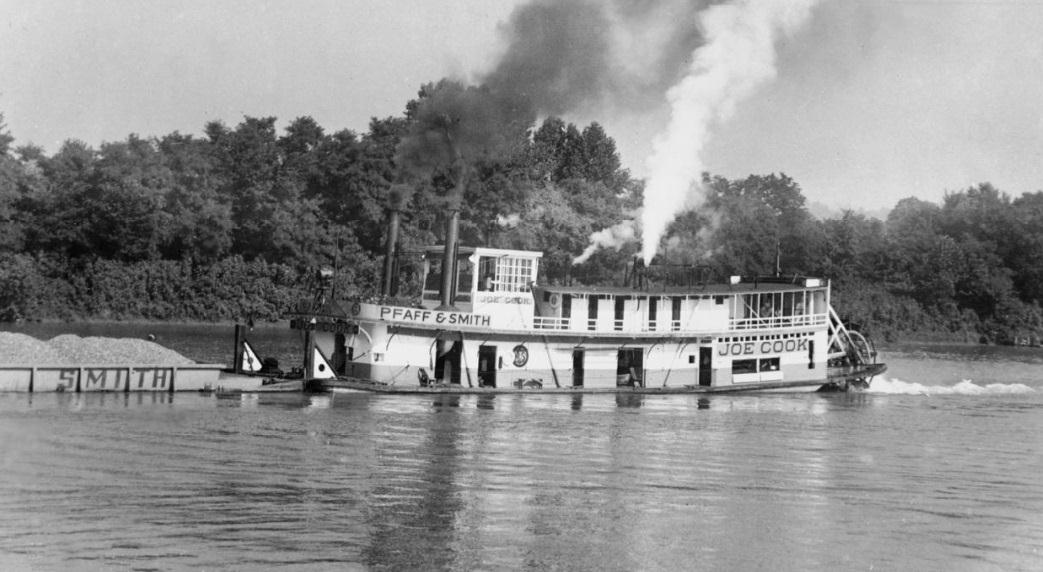
JOE COOK Sternwheel Towboat
Way's Steam Towboat Directory Number T1384
Photo from Murphy Library
Hull built in 1930 at Nashville, Tennessee by Nashville Bridge Company
Owned by Pfaff and Smith Builders Supply Company
Her engines were from the former towboat WESTERN.
In 1947, she got new engines from the snag boat KENTUCKY.
At some point, she was given the whistle from the former packet QUEEN CITY.
She was possibly the first steel hull boat built for the Kanawha River.
On April 1, 1947 she exploded a boiler at Ravenswood, West Virginia.
She had just cleaned boilers there and was raising steam. Three people were killed.
On July 4, 1932, she was torn from her moorings when the Elk River ran out.
Her stacks were knocked down, she ran the weir at Lock 6 and was captured
by the J.C. RAWN.
Retired in 1952
Captain Charles Wells (master); Captain Frank Wright (master);
Nels Bowman (engineer); Clyde Barnett (pilot, 1947)
Dredge Boat
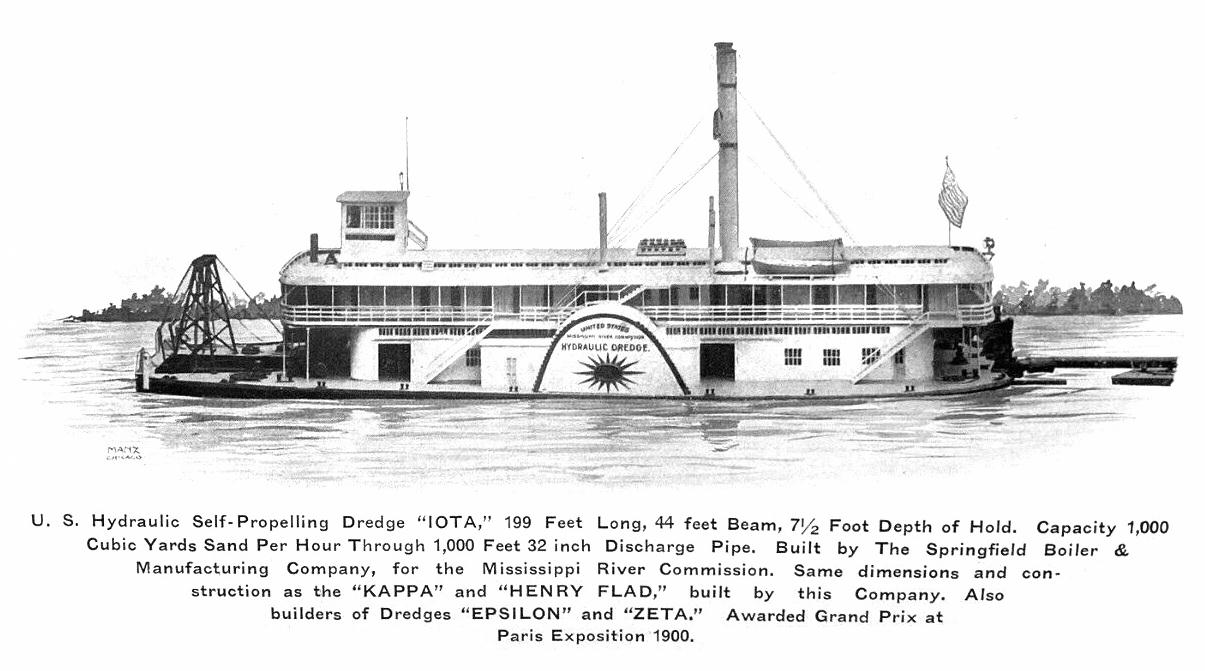
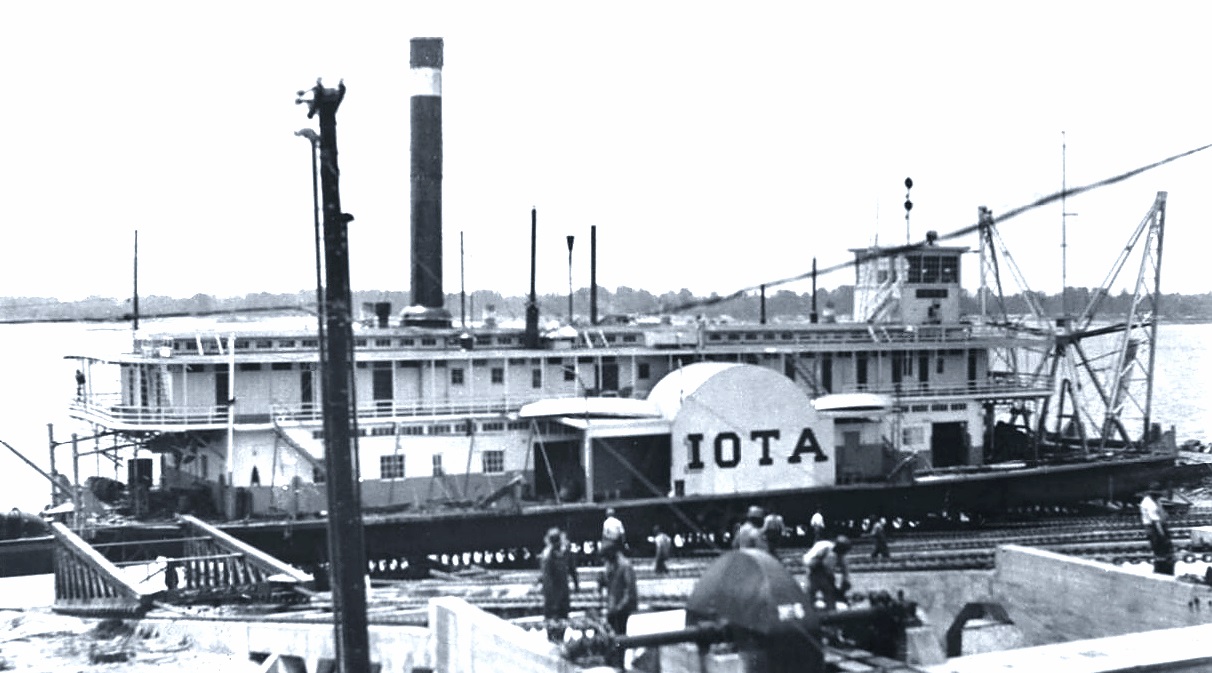
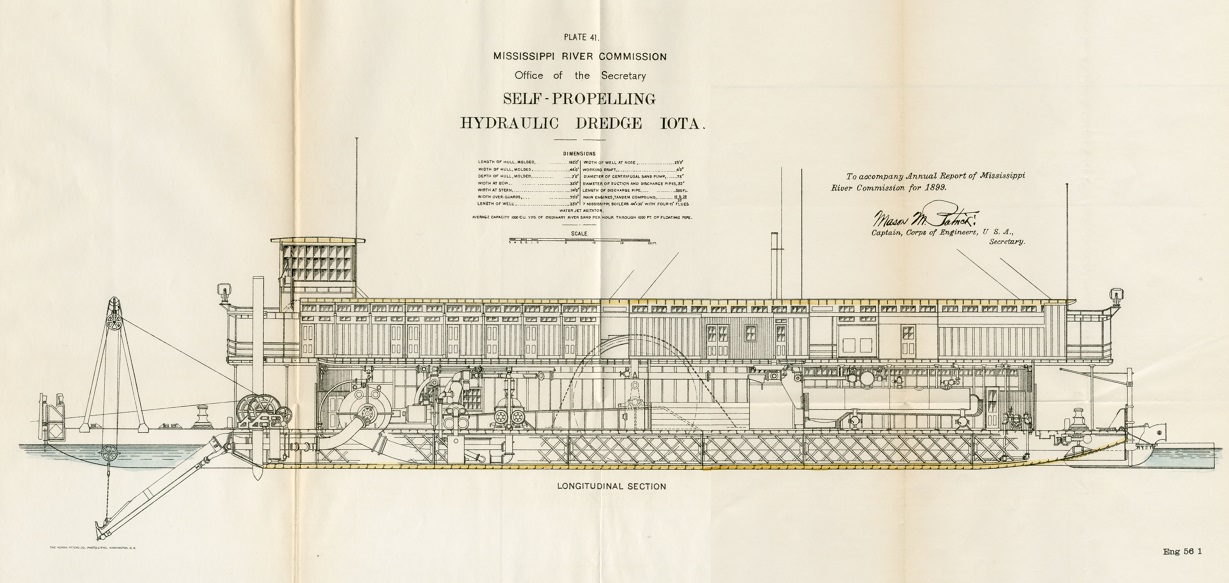 IOTA
IOTA
Self-propelled sidewheel dredge
Built 1901
32" pipeline
U.S. Engineering Department
Mississippi River ~ Memphis District
The graphic with caption below it is from a 64 page Catalog for the Springfield Boiler & Manufacturing Co., Springfield, Illinois circa 1900.
Longitudinal Section Elevation of the Self-Propelling Hydraulic Dredge IOTA from the Annual Report of the Mississippi River Commission for 1899
Photo of the IOTA from La Crosse
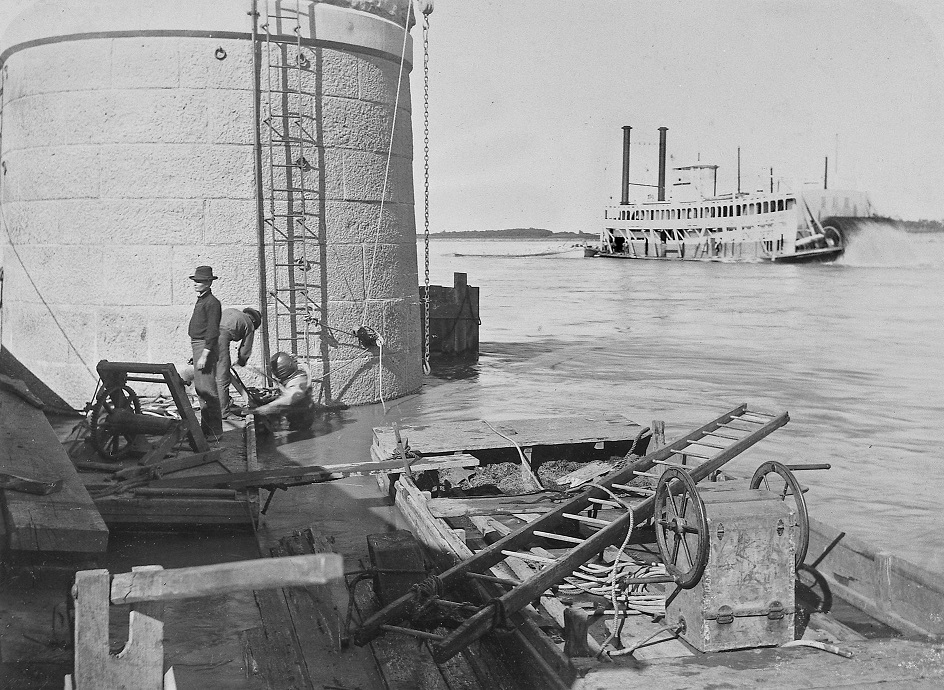
Henry Bosse Sternwheel Towboat
In the foreground is a crew of three men that included a diver in full diving suit working on the maintenance of a water intake tower in the Mississippi River at St. Louis. A barge foreground, the towboat HENRY BOSSE in the background
Henry Bosse
Sternwheel Towboat
Way's Steam Towboat Directory Number T1091
Built in 1881 at Dubuque, Iowa
FORMERLY: the VIXEN (1881) and the DAVID TIPTON (1905)
She worked for the government between Keokuk, Iowa and Burlington, Iowa in 1912 and at Alton, Illinois in 1913.
Owned by U.S. Engineering Department, Rock Island, Illinois
Lost when it capsized in a storm (tornado) on the upper Mississippi just below Keokuk, Iowa on August 19, 1913.
Six of the crew drowned.
OFFICERS & CREW:
1912:
Captain Gus Seifert, master
Campbell Hunt, pilot
1913:
Harry Henderson, chief engineer
Thomas Noonan, 2nd engineer
George Beckel, waterman,
William Jones, deckhand
Mr. and Mrs. William Welch, cooks
Glenn Slee, mate
Charles Henderson, chief engineer
William Guthrie, fireman

With the exception of images credited to public institutions,
everything on this page is from a private collection.
Please contact Steamboats.com for permission for commercial use.*
All captions provided by Dave Thomson, Steamboats.com primary contributor and historian.
